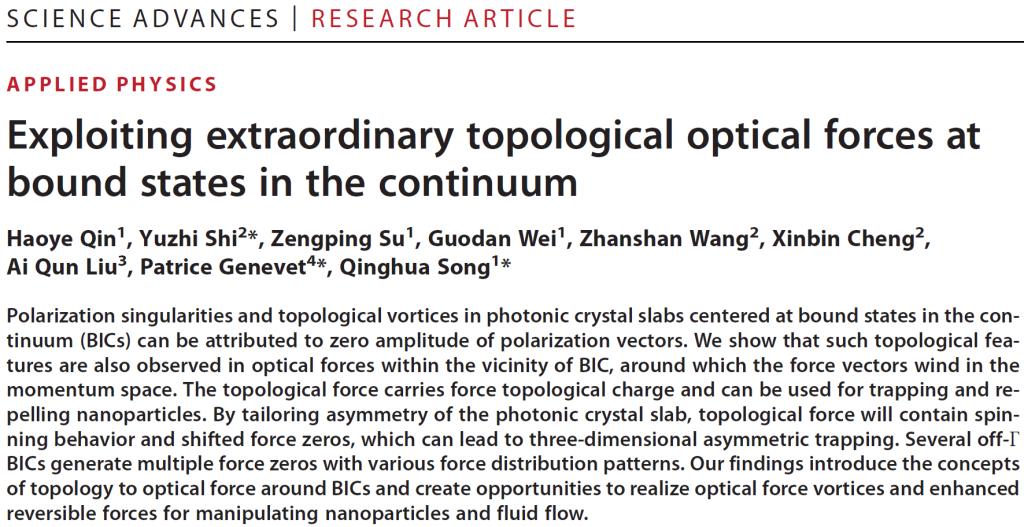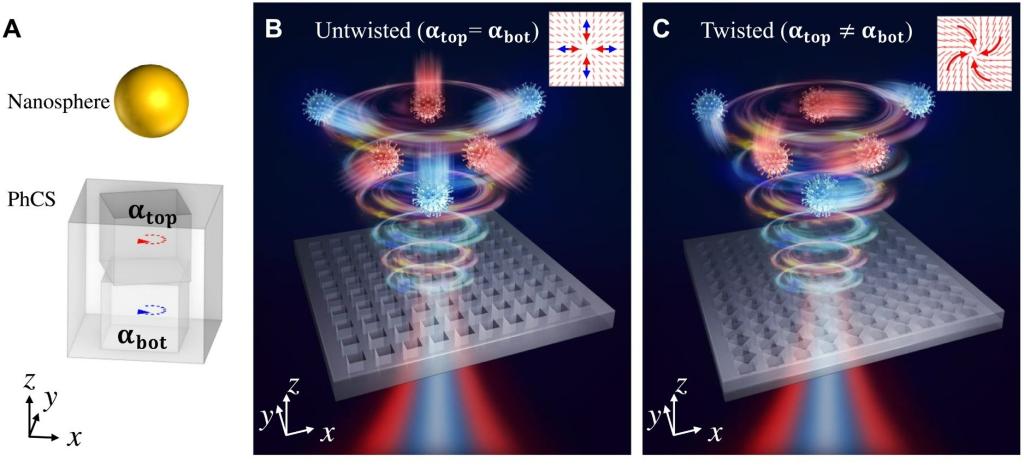On December 10, Beijing time, professor Yuzhi Shi from professor Zhanshan Wang and Xinbin Cheng's team at the School of Physical Science and Engineering, Tongji University, in collaboration with professor Qinghua Song from Tsinghua Shenzhen International Graduate School and professor Patrice Genevet from the French National Center for Scientific Research, published a paper titled "Exploiting Extraordinary Topological Optical Forces in Continuous Domains Exploiting Extraordinary Topological Optical Forces at Bound States in the Continuum" inScience Advances. The paper investigates the extraordinary topological optical forces at the bound states of the continuum (BIC) for the first time, and theoretically reveals the optical field localization capability of BIC, and a new mechanism for stable trapping, repelling and spinning of particles using the topological properties of the polarization singular point. Optical tweezers use the mechanical effect of light and matter interaction to generate optical forces to manipulate tiny particles. Conventional optical forces include gradient forces along the direction of the light intensity gradient and scattering forces along the direction of the wave vector. The gradient force is usually along the direction of the light intensity gradient to the location with the strongest light intensity. However, by studying the optical forces generated by topological charges near the BIC, the research team found that particles above photonic crystal slabs can be subjected to different mechanical effects such as trapping, repelling and spinning under different topological charges (Figure 1), which enriches understandings of optical forces.

BIC is a special optical resonance state that lies in the continuum spectrum of the radiative state, but maintains a perfect localization. As a singular point in the continuum spectrum, the ideal BIC has an infinitely high quality factor and an extremely strong optical field localization capability, which can greatly enhance the light-matter interaction. Thanks to this special property, BIC can be applied to high-quality-factor lasers, biochemical detection, nonlinear harmonic enhancement, etc. In addition, BIC is often used to reveal the topological nature of the far-field radiation polarization state, and is proved to be the vortex center of the far-field radiation polarization vector. It has a quantifiable and conserved topological charge and can be used to realize a vortex beam with a certain topological charge. The research team investigated the dual layer photonic crystal slab (PhCS) and found that both its upper and lower energy bands are capable of achieving BICs with extremely high quality factors, as shown in Figure 2. The far-field radiation polarization states corresponding to the upper and lower energy bands of the symmetric and asymmetric photonic crystal slabs show that the upper and lower energy bands have opposite topological charges.

Figure 1. BIC-induced topological distribution of optical force for manipulation of nanoparticles. (A) Schematic of a PhCS supporting BIC with topological opticalforce for trapping nanospheres in water. Holes in the PhCS can be twisted with a rotation angle of αtop for the top layer and αbot for the bottom layer. (B) Illustration oftopological force for trapping and dispersing nanoparticles on two bands with BICs in untwisted PhCS. (C) Topological force for trapping nanoparticles with spinningpattern in twisted PhCS.
In addition, by studying the far-field radiation light force distribution for symmetric and asymmetric structures, the research team found that the light force vector is akin to the far-field radiation polarization state, which will form a light force vortex around the BIC point and produce a light force singular point at the BIC point. For dual layer symmetric structures, corresponding to the upper and lower energy bands, particles are subjected to a capture force pointing to the center and a repulsive force away from the center, as shown in Figures 2A and 2B; for the dual layer asymmetric structures, i.e., thez-axis symmetry is broken, the far-field radiation polarization state near the BIC will change from the original linear polarization vortex to an elliptical polarization vortex, as shown in Figures 2E and 2F. At this time, corresponding to the upper and lower energy bands, particles are rotating around the center while attracted to the center by the inward vortex force and repelled outward by the outward vortex force respectively, as shown in Figures 3.

Figure 2. (A) Iso-frequency surface and colormappedquality factor of the untwisted PhCS for two eigenmodes (αtop = αbot = 0°). Corresponding distribution of far-field polarization states of (B) the upper band (top)and (C) the lower band (bottom) in (A). (D) Iso-frequency surface and color-mapped quality factor of the twisted PhCS with αtop = 25°, αbot = 0° for two eigenmodes.Elliptical polarization states induced by the twist PhCS for (E) the upper band (top) and (F) the lower band (bottom) in (D).

Figure 3. Topological force distribution around BIC in momentum space withuntwisted PhCS.
By choosing the appropriate structural parameters, eigenstates corresponding to the energy bands can achieve multiple BIC points (Figure 4A), thus forming multiple optical force singular points (Figure 4B) and enabling the simultaneous manipulation of multiple particles. As shown in Figures 4C and 4D, the team also discovered a diamond-like "nothingness" region with near-zero optical force, which can be used for applications such as particle sorting. This research is a pioneering theoretical approach to the realization of optical force, which provides a new idea for particle manipulation and is expected to have important applications in the fields of on-chip multifunctional manipulation, sorting and detection of particles.

Figure 4. Topological features of optical force around off-Γ BIC. (A) Quality factor of one eigenmodeshowing that four off-Γ BICs are obtained. (B) Topological distribution of optical force surrounding four BICs. (C) Quality factor of another eigenmode shows severalBICs enclosing the Γ point. (D) Distribution of optical force around these BICs. Accumulation of these singular points results in nearly zero force within a diamond-likeregion around the Γ point.
Haoye Qin, research assistant from Tsinghua Shenzhen International Graduate School, is the first author of this paper. Yuzhi Shi (professor from the School of Physical Science and Engineering, Tongji University), Patrice Genevet (researcherfromthe French National Center for Scientific Research), and Qinghua Song (professor from Tsinghua Shenzhen International Graduate School), are the co-corresponding authors of the paper. Other collaborators include PhD student Zengping Su and associate professor Guodan Wei from Tsinghua Shenzhen International Graduate School, professors Zhanshan Wang and Xinbin Cheng from School of Physical Science and Engineering, Tongji University, and professor Ai Qun Liu from Nanyang Technological University, Singapore. The research was supported by the Fundamental Research Funds for the Central Universities.
Paper link:https://www.science.org/doi/10.1126/sciadv.ade7556
